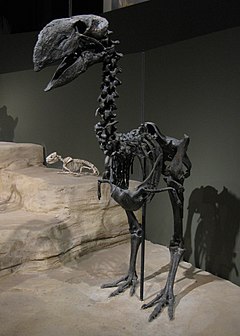
Back غاستورنيس Arabic Gastornis Catalan Gastornis Czech Gastornis Danish Gastornis German Gastornis Esperanto Gastornis Spanish سهمگینمرغ Persian Gastornis Finnish Gastornis French
| Gastornis | |
|---|---|

| |
| Mounted skeleton of Gastornis giganteus, sometimes referred to as Diatryma gigantea | |
| Scientific classification | |
| Domain: | Eukaryota |
| Kingdom: | Animalia |
| Phylum: | Chordata |
| Class: | Aves |
| Order: | †Gastornithiformes |
| Family: | †Gastornithidae Fürbringer, 1888 |
| Genus: | †Gastornis Hébert, 1855 (vide Prévost, 1855) |
| Type species | |
| †Gastornis parisiensis Hébert, 1855
| |
| Other species | |
| Synonyms | |
| |
Gastornis is an extinct genus of large, flightless birds that lived during the mid-Paleocene to mid-Eocene epochs of the Paleogene period. Most fossils have been found in Europe, and some species typically referred to the genus are known from North America and Asia. Several genera, including the well-studied genus Diatryma, have historically been considered junior synonyms of Gastornis. However, this interpretation has been challenged recently, and some researchers currently consider Diatryma to be a valid genus.
Gastornis species were very large birds that were traditionally thought to have been predators of various smaller mammals, such as ancient, diminutive equids. However, several lines of evidence, including the lack of hooked claws (in known Gastornis footprints), studies of their beak structure and isotopic signatures of their bones, have caused scientists to now consider that these birds were probably herbivorous, feeding on tough plant material and seeds. Gastornis is, generally, agreed to be related to the Galloanserae, the group containing waterfowl and gamebirds.